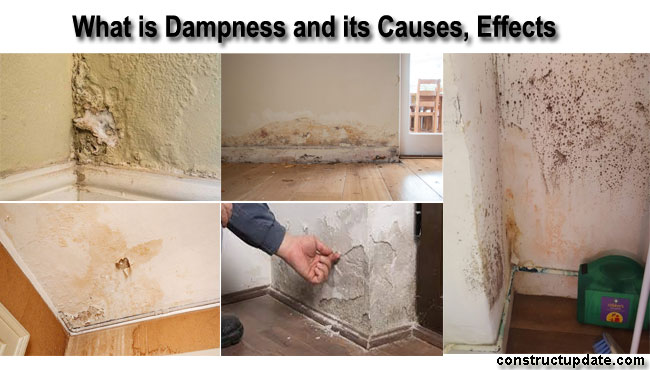What is Dampness | Causes of Dampness | Effects of Dampness
August 9, 2021
What Is Dampness and How Does It Affect You?
The capillary attraction of sub-soil water in the foundation and walls of the building is the most typical source of dampness.
Water can infiltrate masonry due to faulty sills, poor craftsmanship, and therefore a coating of water repellent substance called damp proof course (DPC) is used in buildings to function as a barrier against water capillary rise.
The following are the various sources of dampness in buildings:
- Moisture rising from the ground due to capillary action
- The action of rainwater
- Penetration of rainwater from the top of the building
- Condensation due to atmospheric moisture
- Miscellaneous sources or causes such as poor drainage of a building site, imperfect orientation of a building, defective construction, and so on.
Use of Faulty Materials:
- Contact with vegetation
- Contact with banked earth
- Defective roofs and gutters
- Defective window sills
- Defective parapet wall
- Rising moisture through walls and floors due to capillary action
- The splashing of water on wall surfaces
- Leakage from the site, which can lead to waterlogging and, eventually, moisture in a building.
- Roof drainage issues include leakage via the roof and roof joints.
Dampness’s Effects on Buildings:
Dampness has a negative impact on the structure. The following are some of the most noticeable impacts of dampness:
- A moist structure is not only unhealthy for its people, but it also encourages mosquito breeding.
- Corrosion of metals used in the building’s construction is possible.
- The unattractive blotches appear on the ceilings and surfaces of the walls.
- In a damp environment, the degradation of wood occurs quickly owing to dry-rot.
- It causes plaster to weaken and crumble in a 1:1 ratio.
- It encourages the spread of termites.
- The walls may produce efflorescence, resulting in the disintegration of stones, bricks, tiles, and other materials, reducing the wall’s strength.
- The materials used to cover the floors have been severely harmed.
- Electric fittings deteriorate over time, posing a risk of short-circuiting.
- In a damp structure, residents live in an unhealthy environment.
- Efflorescence occurs on building surfaces, resulting in the disintegration of bricks, stones, tiles, and other materials, reducing the useful life of a structure.
- It causes paint to bleach, resulting in the creation of coloured patches on the walls and ceilings.
- It causes the plaster to weaken and crumble.
- Timber deteriorates when it comes into touch with water owing to bending, buckling, and rolling.
- Termites thrive in damp environments.
- Patches of the wall’s surface are impacted. On the walls can be observed. The point is turned off, and the colours fade.
- The dimensions of the timer-based building parts were altered. The wood could rot.
Dampness is caused by a variety of factors.
Dampness in a structure is a common issue. The following are the different causes of dampness in a structure:
- Rising moisture from the earth
- Action of rain
- Exposed tops of walls
- Condensation
- Miscellaneous






